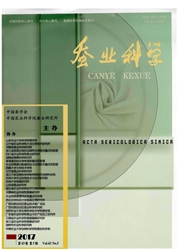

 中文摘要:
中文摘要:
分子标记是生物系统进化和亲缘关系分析的重要手段。利用RAPD和SSR标记对12个家蚕实用品种的基因组DNA进行多态性分析和聚类分析。采用21条RAPD引物对12个品种的基因组DNA扩增产生的清晰稳定条带数为196条,其中多态性片段143条,多态位点比例72.96%,品种间的遗传距离在0.157~0.352之间。采用32条SSR引物对12个品种的基因组DNA扩增产生的片段数为86条,其中多态性带80条,多态性位点比例93.02%,遗传距离在0.214~0.600之间。对12个家蚕品种的2种分子标记的单独聚类结果表现出一定差异,但均把12个品种分为中系、日系两大类,其中7532和湘晖、871和57B的亲缘关系较近,而传统分类于中系品种东34却聚类于日系,但又独立于其余6个日系品种。结合RAPD标记和SSR标记的12个品种间的遗传距离与聚类结果,更能准确地从分子水平上反映品种间的亲缘关系及其来源,是家蚕杂交育种亲本选择的依据。
 英文摘要:
英文摘要:
Molecular marker technique is an important method in studying phylogenetic evolution and genetic relationship of organisms.The DNA polymorphism of 12 commercial silkworm varieties was analyzed based on RAPD and SSR molecular markers.Subsequently,cluster analysis was conducted.By using 21 RAPD primers to amplify the genomic DNAs of 12 silkworm varieties,196 clearly distinguishable bands were obtained,among which 143 bands showed polymorphism,showing a polymorphism percentage of 72.96% and relative genetic distances ranging from 0.157 to 0.352 between different varieties.By using 32 SSR primers to amplify the genomic DNAs of 12 silkworm varieties,86 distinguishable bands were obtained,among which 80 bands showed polymorphism,showing a polymorphism percentage of 93.02% and relative genetic distances ranging from 0.214 to 0.600 between different varieties.Although cluster analyses based on RAPD and SSR molecular markers of the 12 silkworm species yielded different results,both results classified the 12 silkworm varieties into Chinese strain and Japanese strain,among which the genetic relationship between strains 7532 and Xianghui and between strains 871 and 57B were relatively closer.However,Dong 34,a variety that belongs to Chinese strain in the traditional classification,was classified into Japanese strain,though it was independent of other 6 varieties from Japanese strain.The genetic distances and cluster results of the 12 varieties based on RAPD and SSR molecular markers could reflect genetic relationship and origin of different varieties at the molecular level more accurately,being important references for parent selection in silkworm cross breeding.
 同期刊论文项目
同期刊论文项目
 同项目期刊论文
同项目期刊论文
 期刊信息
期刊信息
